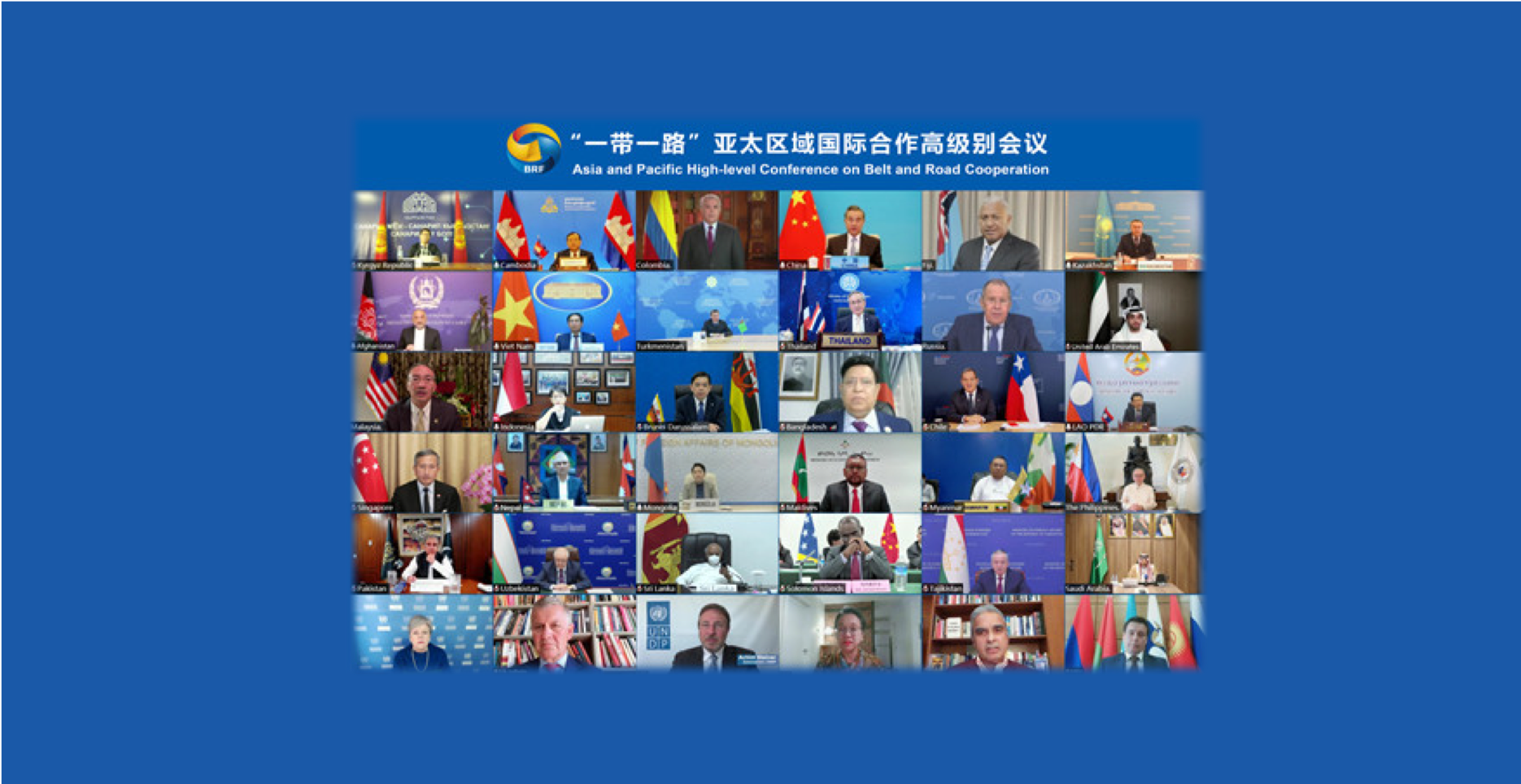On June 23, 2021, during a virtual conference, political leaders of 29 partner countries of the Belt and Road initiative (BRI) launched the Initiative for Belt and Road Partnership on Green Development (“BRI Green Partnership”). Chinese State Councilor and Foreign Minister WANG Yi presided over the conference during the Asia and Pacific High-level Conference on Belt and Road Cooperation, which convened deputy prime ministers, foreign ministers and other political leaders from the 29 countries, as well as representatives of international organizations, such as ESCAP, UNDP and the Economic Commission for Latin America and the Caribbean (ECLAC). The 29 countries represent more than 68% of the total BRI financing and investment by China since 2013 (about USD 520 billion).

The BRI Green Partnership emphasizes international collaboration for a green and sustainable recovery, and a low-carbon transition leading up to the 2030 Agenda for Sustainable Development (SDGs) and the Paris Agreement. Specifically, it lays out important focus areas for cooperation, recognizing the progress made by the Belt and Road Initiative International Green Development Coalition (BRIGC) and the Green Investment Principles for Belt and Road (GIP).
This article provides an overview and interpretation of the BRI Green Development Initiative in the context of BRI investments in the 29 countries, and evaluates its development in light of the G7’s “Build Back Better World” Initiative (“B3W”). Finally, the article concludes with four policy recommendations for a strengthened green development of the BRI.
1. The launch of the BRI Green Development Initiative
China and partners have been working on “building a green BRI” through various guidance and principles for several years. Relevant documents include, for example, the “Guiding Opinions on Promoting the Construction of Green One Belt One Road” issued in 2017, the Green Development Guidance with the Traffic Light System for BRI projects issued by the BRIGC in December 2020 and the seven green investment principles (GIP) signed by 39 Chinese and international financial institutions and partners.
However, so far, these initiatives have been mostly driven by Chinese stakeholders (supported by international partners) and voluntary by nature, while international agreements on ambitions and principles to build a green BRI have been lacking.
This makes the new Partnership different for three reasons:
- First, this new initiative was jointly launched and agreed on by high-level political leaders from the 29 countries, including presidents, deputy prime ministers and foreign ministers. This indicates an important buy-in from relevant top-leaders of BRI countries on the policy level to steer green development in the partner countries, and a stronger willingness to apply common standards;
- Second, the initiative highlights the need to reduce environmental risks through “internationally recognized standards and best practices”. This suggests a willingness to require common standards rather than compliance to “host country principle”, which requires application of often lower host country environmental standards with negative environmental risk consequences;
- Third, by highlighting the work of the Belt and Road Initiative International Green Development Coalition (BRIGC) and the Green Investment Principles for the Belt and Road Initiative (GIP), the Initiative possibly alludes to common standards to be applied in the further construction of the BRI. In one of the speeches at the conference, Erik Solheim, the international convener of the BRIGC, highlighted the traffic light system as a potential common standard, as well the BRIGC’s work on greening supply chains.
The BRI Green Development Partnership builds on the shared responsibility of working towards ecological and environmental protection in line with the 2030 Agenda for Sustainable Development and the Sustainable Development Goals (SDGs) and the Paris Agreement guided by the “common but differentiated” responsibilities principle. Overall, the Initiative focuses on climate change and green recovery, but it also includes broader environmental concerns in its cooperation areas (see full text here):
- Develop relevant economies in a “balanced and integrated manner” between economic, social and environmental goals in line with the Sustainable Development Goals (SDGs) set out in the 2030 Agenda for Sustainable Development;
- Focus on low-carbon development to fight climate change, including a focus on clean energy;
- Promote environmentally-friendly and resilient infrastructure through “inter alia” internationally recognized standards and best practices on climate and environmental risk assessment;
- Promote green finance;
- Support capacity building and coordination on green development through sharing experiences, “to achieve harmony between Human and Nature for green and sustainable development”.
2. The Green Belt and Road Partnership versus G7’s B3W
The Green BRI Partnership was announced just weeks after the G7 countries initiated “Build Back Better World” (“B3W”). The B3W proclaims a goal of G7 countries to provide an alternative to the BRI for green and sustainable development in emerging countries.
Both the new BRI Green Partnership and G7’s B3W highlight the importance of building green and high-quality infrastructure. The G7 partners agree to provide and mobilize financing to close the USD40 trillion dollar infrastructure gap. They want to build infrastructure based on multilateral agreed standards and align their outbound investment with the Paris Agreement.
Accordingly, both the BRI Green Partnership and G7’s B3W have emphasized mobilizing private capital. While the BRI might have an advantage in doing so due to China’s state-ownership of financial institutions and project developers providing a clear accountability between business and government, activities of private investors and developers from G7 countries are driven pre-dominantly by pure economic interests with little influence by government agencies.
To better understand the commonalities and differences, we compare the ambitions of the the BRI Green Partnership and the G7’s B3W initiative regarding the overall goals, values, financing, environmental standards, etc. (see Table 1):
Comparisons between BRI Green Partnership and the G7’s B3W
| Aspect | BRI Green Partnership | Build Back Better World (B3W) |
| Overall goals of initiative | Policy facilitation, Facility connectivity, Unimpeded trade, Financial integration, People-to-people connectivity | Global infrastructure development for green growth |
| Explicit goals in regard to sustainable development | Environment (it is important to note that during the summit on June 23, also a separate vaccine cooperation was announced) | Climate, health, health security, digital technology, gender equity and equality |
| Scope | BRI countries | Low and middle-income countries across the globe (with different focus areas for each partner) |
| Partners | 29 countries and “looking forward to the participation of more partners” | G7 “and other like-minded partners” |
| Values | Principle of equity, Common but differentiated responsibilities, International collaborative efforts, Policy communication and coordination on green development | Transparency, Sustainable – particularly financially, environmentally and socially, Good governance – particularly in relation to labor, climate, social safeguards, anti-corruption Strategic partnerships – through common consultation |
| Financing | National and international financial institutions | Bilateral and multilateral development finance institutions Mobilizing private capital through development finance |
| Environmental Standards | “Drawing upon internationally recognized standards and best practices” | Blue Dot Network standards Standards by multilateral development banks and international financial institutions |
| Time-frame | Not specified, but seemingly long-term for BRI cooperation | Not specified, but seemingly focusing on the period of COVID-19 recovery |
3. Recommendations for strengthening a green BRI
To accelerate building a greener, more inclusive and dynamic development in the BRI and beyond and to utilize the momentum provided by both the new Partnership and the G7’s B3W, four issues should be addressed:
- Green standards: Developing and applying common “green standards” for BRI project development is a basic requirement to reduce environmental risks throughout all development stages. These standards need to guide relevant financial institutions, investors, project sponsors and local stakeholders and should align with international best practices for project design, construction, reporting and maintenance. An example is the Green Development Guidance for BRI Projects published by the BRI International Development Coalition in December 2020. The Guidance classifies BRI projects from the environmental perspective, and provides guidance on environmental risk management system to allow for differentiated analysis based on local specificities.
- Social standards and grievance mechanisms: For project sponsors and financial institutions in the BRI, social risks have exacerbated, while local societies need to better benefit from job creation and better livelihoods. Although specifics on social development goals might differ among countries, social benefits should be maximally distributed rather than concentrated, and social grievances need to be addressed. Therefore, developers and financial institutions need to engage in in-depth stakeholder consultation to find development needs, and identify possible grievances. Accordingly, they should also establish open and transparent grievance mechanisms to identify and manage potential social risks throughout the project lifecycle.
- Multilateral cooperation: cooperation with multilateral and bilateral financial institutions and initiatives, including G7’s B3W, can accelerate financial resource mobilization, while improving co-benefits that can be unlocked for the host and the initiating countries, from improved health system and enhanced digital connectivity to better economic and social development. Furthermore, the Partnership should utilize knowledge networks and capacity building, as well as standard setting opportunities through multilateral organizations, such as the AIIB, World Bank, UN and others.
- Biodiversity: while the BRI Green Partnership integrates broad goals on developing in harmony with ecology and environment, relevant goals and standards should be specified to include biodiversity protection and restoration. These can include nature-based solutions and nature-climate solutions to reduce high vulnerabilities to climate change and biodiversity loss.
Slider photo credit: Ministry of Foreign Affairs of the People’s Republic of China






Comments are closed.